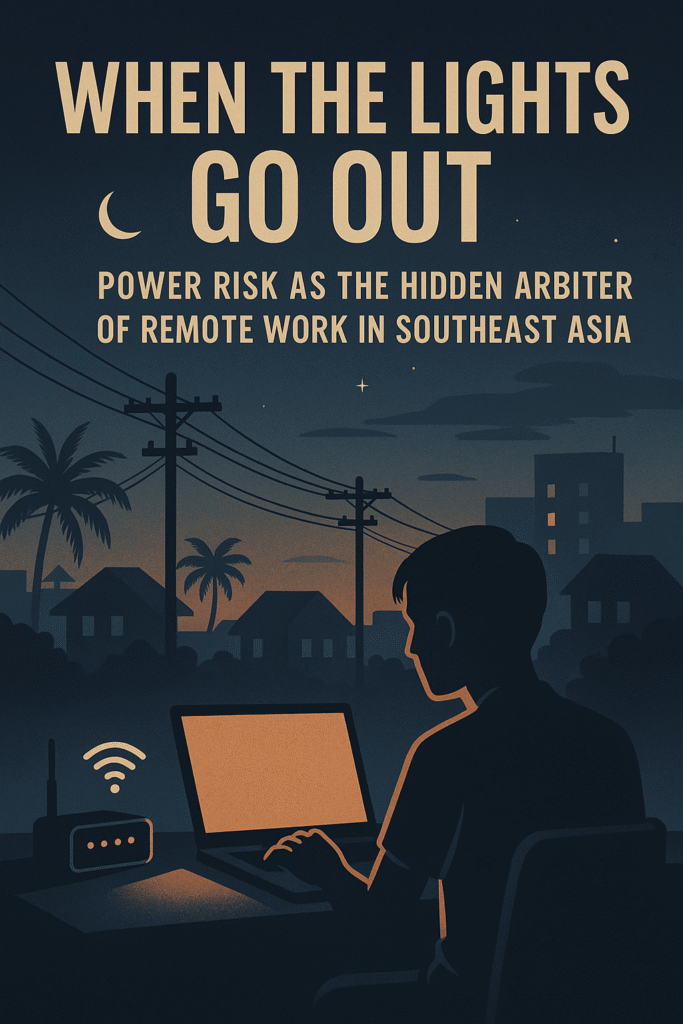When Nomads Have to Work in the Dark — and How Digital Nomads Keep Working When the Power Fails

What happens when your productivity comes to a standstill—not due to poor connectivity, but because the electricity simply fades away?
I encountered this firsthand during my initial return to Iligan City, my birthplace in southern Philippines. I was in the middle of an upload when the lights flickered out. My modem shut down, the fan ceased whirring, and the progress bar stalled at 68%. Back then, I didn’t know this was a typical scheduled outage—one that residents were already accustomed to tracking. Eventually, I’d discover how to access those timetables and adjust my routine accordingly. But right then, I grasped a lesson that many digital nomads eventually confront: the greatest obstacle to your remote setup isn’t always bandwidth—sometimes, it’s the power supply itself.
Electricity: The Overlooked Backbone of Remote Work
Countless pieces on digital nomad experiences focus on familiar topics: prime beach spots, dependable internet access, straightforward visa processes, and tips for securing flexible jobs. We craft this way of life around flexibility, independence, and connectivity. Yet, one essential element is seldom discussed—something overlooked in travel resources or nomad communities, but utterly vital: a reliable electrical supply.
Remote productivity depends on far more than speedy Wi-Fi. Electricity forms the core foundation. Your internet modem, networking devices, and other vital equipment all cease functioning without it. Your computer might continue on battery power temporarily—but without electricity for your router or secondary setups, vital file transfers, data synchronizations, or virtual meetings stall completely. While we fixate on bandwidth rates and stylish workspaces, we often neglect the fundamental enabler: a dependable electrical network.
In many parts of Southeast Asia, the electrical system isn’t as dependable as it appears. Voltage reductions—short dips or planned interruptions—are everyday occurrences. For nomads, grasping this pattern early allows you to build a routine that harmonizes with it.
This overview examines the actual electrical conditions in major SEA destinations, provides adaptation techniques, and shares tactics to ensure that when the power wavers, your productivity remains steady.
Grasping Voltage Reductions: Their Nature and Causes
Voltage reductions differ from total outages. They involve partial decreases in electrical supply or deliberate throttling. They may be planned to handle network strain, or triggered by extreme temperatures, outdated systems, or disruptions to transmission lines.
Total outages = total absence of electricity.
Voltage reductions = temporary voltage sags; illumination might fade, gadgets could reboot.
Demand management = planned interruptions to even out network usage.
Many urban areas in SEA experience a mix of these, particularly in high-demand afternoons, during heat spells, or amid severe weather.
Regional Overview: Areas Prone to Electrical Disruptions and Their Reasons
| Country | Urban Hubs (Network Reliability) | Vulnerable Areas | Key Insights |
|---|---|---|---|
| Philippines | Metro Manila reliable in modern structures | Islands, rural regions | Frequent planned reductions; interruptions spike in hot periods |
| Indonesia | Jakarta dependable | Bali, isolated villages | Island-based mini-networks; inconsistent reserve power |
| Thailand | Bangkok, Chiang Mai robust | Coastal spots, typhoon-prone zones | Occasional dips linked to high usage or system overload |
| Malaysia | KL exceptionally steady | Isolated forest/rural spots | Generally minimal issues in urban zones; infrequent disruptions |
| Vietnam | Hanoi, HCMC, Da Nang trustworthy | Peripheral areas, summer heat periods | Sporadic failures during bad weather or peak consumption |
Why This Affects Nomads
Even with flawless high-speed internet, an electrical glitch knocks out your router. Secure connections break. File transfers halt. Video conferences drop.
This issue intensifies for roles requiring:
Real-time interactions or video conferences
Transferring sizable files (graphics, multimedia, programming)
Ongoing cloud backups with instant updates
And don’t overlook the psychological strain: the perpetual anxiety of, “Is the electricity going to fail today? Should I send this file immediately or hold off?”
Practical Tactics: Navigating Electrical Interruptions
- Track the Timetables Most reductions follow predictable patterns. Consult locals or scour the web for your area’s utility maintenance roster. Numerous providers release district-specific interruption plans. With that knowledge, you can align your productive periods around them—or time your downtime accordingly.
- Essential Power Reserves
- Uninterruptible power systems (UPS) for modems and routers
- Compact power banks (500Wh or more to sustain a router and computer for 2–3 hours)
- Compact router-specific UPS units (affordable and targeted)
- Surge protectors to safeguard devices from post-dip fluctuations
- Backup Communication Options
- A cellular data device (4G/5G card) as an alternative when fixed Wi-Fi fails
- Store documents on your device, avoiding full dependence on online storage
- Employ automatic saving features and tools that function offline
- Evaluate Accommodations Based on Electricity When selecting a place to stay:
- Inquire about emergency generators
- Verify auxiliary power in shared spaces (particularly in communal living setups)
- Poll nearby residents on outage patterns and durations
- Align Tasks with Electrical Cycles
- Time meetings and transfers for reliable windows
- Back up locally frequently and opt for tools that resume interrupted uploads
- Embrace that these interruptions can shape your daily rhythm—and that’s fine
Reliability Assessments: Top and Riskiest Urban Spots for Electrical Stability
Safest choices: Kuala Lumpur, Bangkok, Ho Chi Minh City, downtown Da Nang
Intermediate: Central Chiang Mai, Penang, urban Cebu
Elevated danger: Distant Philippine islands (Siargao, Palawan), countryside Indonesia, outlying Vietnam
In riskier locations, digital nomads still flourish with proper foresight. It’s not about steering clear of these spots, but about adapting intelligently to their realities.
Closing Reflection: Integrate Electricity into Your Strategy
Electrical dips aren’t catastrophes. They serve as cues that underlying systems influence our mobility. Remote productivity extends beyond quick internet—it’s about anticipating the infrastructures we depend on, including those out of sight.
Thus, the true inquiry isn’t “What occurs if the electricity fails?” It’s: How will you navigate it—and thrive amid it—when it inevitably does?
If you enjoyed this piece, you might also like my earlier article: AI Skill Videos for Digital Nomads: Hype, Help, or Hustle?
